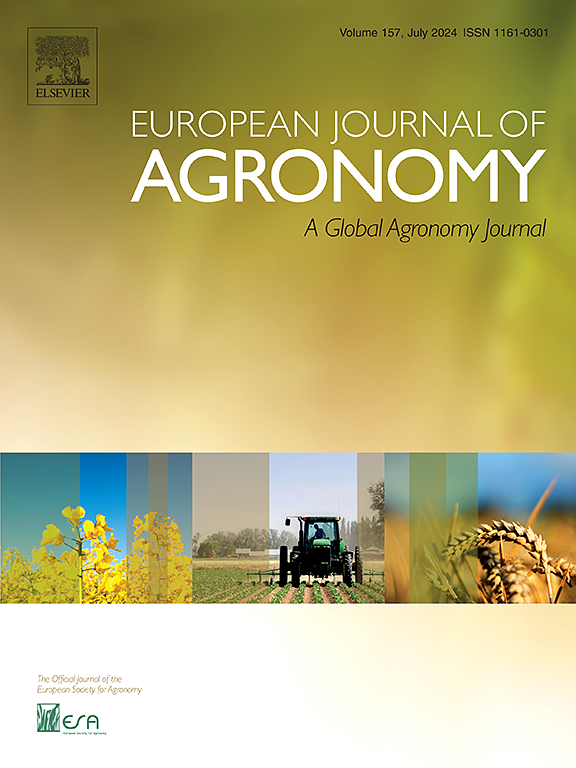利用机器学习,通过高光谱反射率和特征选择方法判别小麦赤霉病感染程度
IF 4.5
1区 农林科学
Q1 AGRONOMY
引用次数: 0
摘要
实时或症状前小麦赤霉病(WS)检测是精准农业的必然选择,可在谷物形成的关键阶段确保产量和质量。为此,特征选择(FS)技术和机器学习(ML)技术已经证明了它们的能力。然而,对于相同类型和大小的数据集,所有 FS 和 ML 技术因其主要成分的不同而表现各异。本研究尝试在小麦穗的高光谱数据上采用不同的 FS 技术,利用 ML 进行 WS 分类和预测。我们选择并评估了光谱特征,以便对病害发生进行回归和分类。浮雕-F-神经网(NN)效果最佳,在症状前和接种后 3 天(DAI)的分类准确率(CA)分别为 67% 和 89%。其次是连续小波变换(CWT)-NN,在症状出现前的分类准确率为 63%,CWT-Xgboost 在接种后 3 天的分类准确率为 89%。在预测方面,随机森林回归的准确率最高,为 R2 = 0.94 和 RMSE = 7.70,其次是偏最小二乘回归,R2 = 0.90 和 RMSE = 10.37。这些结果为今后研究高光谱数据和 FS 实时量化植物病害的能力提供了一个精确的量化基准。本文章由计算机程序翻译,如有差异,请以英文原文为准。
Leveraging machine learning to discriminate wheat scab infection levels through hyperspectral reflectance and feature selection methods
Real-time or pre-symptomatic wheat scab (WS) detection is inevitable for precision agriculture to secure yield and quality at the critical grain formation stage. For this, feature selection (FS) techniques and machine learning (ML) have demonstrated their capabilities. However, for the same type and size of dataset, all FS and ML techniques behave differently due to their diverse primary constituents. This study attempts to leverage ML for WS classification and prediction employing different FS techniques on hyperspectral data of wheat spikes. The spectral features were selected and assessed to regress and classify disease occurrence. Relief-F-neural net (NN) manifested the best results with classification accuracy (CA) of 67 % and 89 % at the pre-symptomatic scale and 3 days after inoculation (DAI), respectively. Followed by continuous wavelet transform (CWT)-NN with 63 % CA at the pre-symptomatic scale and CWT-Xgboost with 89 % CA at 3DAI. For prediction, random forest regression revealed best accuracy of R2 = 0.94 and RMSE = 7.70, followed by partial least squares regression with R2 = 0.90 and RMSE = 10.37. The results offer a precise quantitative benchmark for future investigations into the capacity of hyperspectral data and FS for the real-time quantification of plant diseases.
求助全文
通过发布文献求助,成功后即可免费获取论文全文。
去求助
来源期刊

European Journal of Agronomy
农林科学-农艺学
CiteScore
8.30
自引率
7.70%
发文量
187
审稿时长
4.5 months
期刊介绍:
The European Journal of Agronomy, the official journal of the European Society for Agronomy, publishes original research papers reporting experimental and theoretical contributions to field-based agronomy and crop science. The journal will consider research at the field level for agricultural, horticultural and tree crops, that uses comprehensive and explanatory approaches. The EJA covers the following topics:
crop physiology
crop production and management including irrigation, fertilization and soil management
agroclimatology and modelling
plant-soil relationships
crop quality and post-harvest physiology
farming and cropping systems
agroecosystems and the environment
crop-weed interactions and management
organic farming
horticultural crops
papers from the European Society for Agronomy bi-annual meetings
In determining the suitability of submitted articles for publication, particular scrutiny is placed on the degree of novelty and significance of the research and the extent to which it adds to existing knowledge in agronomy.
 求助内容:
求助内容: 应助结果提醒方式:
应助结果提醒方式:


